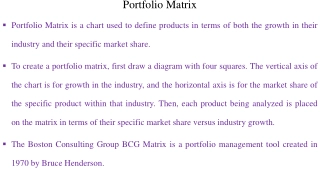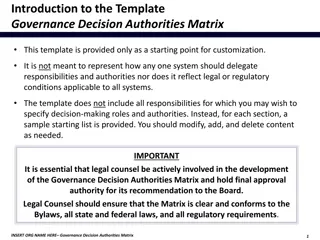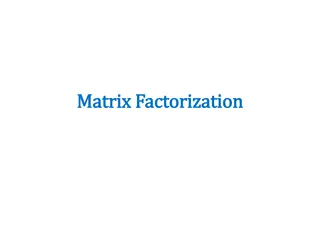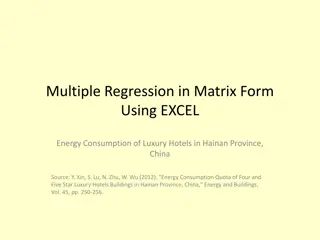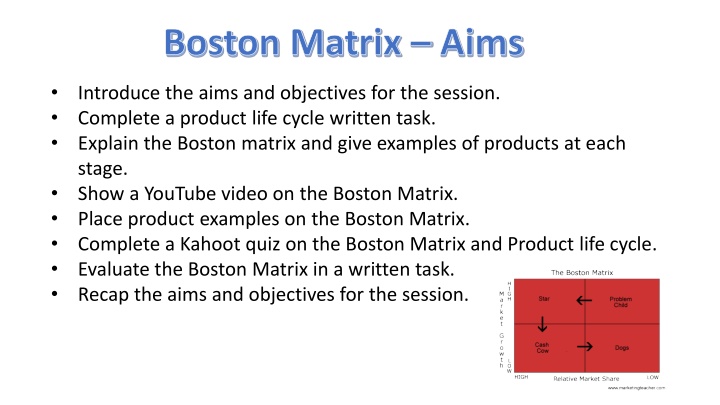
Boston Matrix: Product Life Cycle and Analysis Guide
Explore the Boston Matrix, a tool for analyzing products based on market share and growth. Learn about Cash Cows, Stars, and Question Marks, with examples like Ford Focus and Apple Watch. Engage in activities like a product life cycle task, YouTube video, and Kahoot quiz to understand product management better.
Download Presentation

Please find below an Image/Link to download the presentation.
The content on the website is provided AS IS for your information and personal use only. It may not be sold, licensed, or shared on other websites without obtaining consent from the author. If you encounter any issues during the download, it is possible that the publisher has removed the file from their server.
You are allowed to download the files provided on this website for personal or commercial use, subject to the condition that they are used lawfully. All files are the property of their respective owners.
The content on the website is provided AS IS for your information and personal use only. It may not be sold, licensed, or shared on other websites without obtaining consent from the author.
E N D
Presentation Transcript
Boston Matrix Aims Introduce the aims and objectives for the session. Complete a product life cycle written task. Explain the Boston matrix and give examples of products at each stage. Show a YouTube video on the Boston Matrix. Place product examples on the Boston Matrix. Complete a Kahoot quiz on the Boston Matrix and Product life cycle. Evaluate the Boston Matrix in a written task. Recap the aims and objectives for the session.
Activity 1 Product life cycle Task: Product life cycle Past paper question. Time: 20 mins
Boston Matrix (BCG, 1960) The Boston Matrix was devised by the Boston Consultancy Group in the 1960s and it allows the analysis of a business s products by dividing the products into four categories. The categories the products are placed in depend on their market share and the level of growth that is occurring in the market. This structure can be used as a guide to product mix management.
Cash cows Cash cows (High market share slow market growth) Cash cows are very profitable products and expenditure on such things as advertising is relatively low. Customers know and understand the product, and brand value has been established. It is also likely that development costs have already been recouped, increasing profitability further.
Cash cows Examples: Ford Focus Kellogg s Corn Flakes Cadbury s Dairy Milk Can you think of an example?
Stars Stars (High market share fast market growth) The market may be somewhat immature, with new customers being attracted to the marketplace and new competitors being tempted by potential profits and market share. Competition is high businesses are fighting for a share of potentially huge profits. Stars are products that have a high market share in a fast growing market. Star products have high levels of revenue, but also have high levels of costs. Advertising and marketing expenditure is high.
Star examples Brands have to be established and hopefully the products will develop into cash cows. The classic example of a recent product that was a star and has become a cash cow is the Apple iPad. Examples : Apple watch Can you think of an example?
Question marks Question marks/Problem children (Low market share fast growing market) This is one of the worst situations for professional marketing people. They have a product in a fast growing market but the products are not selling. They are being beaten by the competition. They are failing, but it is likely to be worth doing something about it. After all, it is not good business for businesses to have products that fail to capture market share in markets that are growing in importance.
Question marks For products which are question marks, a product relaunch may solve the problem or a basic redesign may increase sales. In the mid 1980s jeans were out of fashion but the market for teenage clothes was growing fast. Levi's relaunched their jeans, led by advertising for 501s, which had never been a style of jean worn for fashion. Within a few months sales had increased by a 10 times the product became a star.
Question marks gone bad ! In contrast, there have been many competitors to the iPad since launch and most have ended up as question marks, heavily discounted and eventually withdrawn.
Dogs Dogs (Low market share slow growing or shrinking market) Dogs have low market share in a mature market. It is not generally worth spending money on redeveloping, redesigning or advertising the products as it is unlikely to be recouped in increased revenue. Even so, dogs may still be marginally profitable. Problems with dogs exist as they may take up management time, tie up assets and give very low returns. The issues surrounding so-called dog products can be quite complex.
Dogs Some businesses still sell hand carpet sweepers. You do not see them advertised on TV, competing for market share against the Dyson, but they still produce profits for niche businesses. The development costs of this type of product were paid back long ago, marketing is virtually non-existent and they are profitable enough to ensure that manufacture continues.
Dogs Currently sales of alcohol through public houses are falling and there is a shrinking market. Businesses with a portfolio of bars and pubs sell off the less successful ones (often small pubs with no food facilities) and focus on large city centre bars and gastropubs where profits are higher.
Dogs Cut or keep ? Can it be worth holding on to dogs? A business may also subsidise loss-making products in order to appear ethical thereby winning customers and enhancing their reputation. If a business has dogs that are unproductive, one solution is to sell off the dogs to small specialist niche businesses and use the money raised to invest in developing new products.
How to use Boston Matrix (A03) Businesses must ensure that they use the Boston Matrix in the way intended: To judge how to manage individual products and the product range, given market conditions; To recognise the importance of using successful, profitable products to fund the development of the stars and cash cows of the future; To see whether they have products in fast growing and potentially very profitable market sectors.
Boston Matrix usefulness (A03) The Boston Matrix can help businesses analyse whether they have the portfolio that they want and whether it matches the objectives of the organisation. From analysing their product portfolio using the Boston Matrix, managers can then establish their marketing strategy in order to obtain the desired portfolio.
Boston Matrix best sections Most businesses would like to have a product mix or portfolio which has no problem children, many cash cows and plenty of stars that look like developing into cash cows. However, in the real world there are very few businesses that are that successful. Even Microsoft, the world s largest software company, is struggling in some sectors including tablets and mobile phones.
YouTube video Boston matrix https://www.youtube.com/watch?v=rW5SOENyq5g
Activity 2 Task: Place products on the Boston Matrix Time: 10 mins
Activity 3 Task: Boston Matrix Exam question. Time: 30 mins
Activity 4 Task: Kahoot quiz PLC and Boston matrix Time: 15 mins
Boston Matrix Aims Introduce the aims and objectives for the session. Complete a product life cycle written task. Explain the Boston matrix and give examples of products at each stage. Show a YouTube video on the Boston Matrix. Place product examples on the Boston Matrix. Complete a Kahoot quiz on the Boston Matrix and Product life cycle. Evaluate the Boston Matrix in a written task. Recap the aims and objectives for the session.

